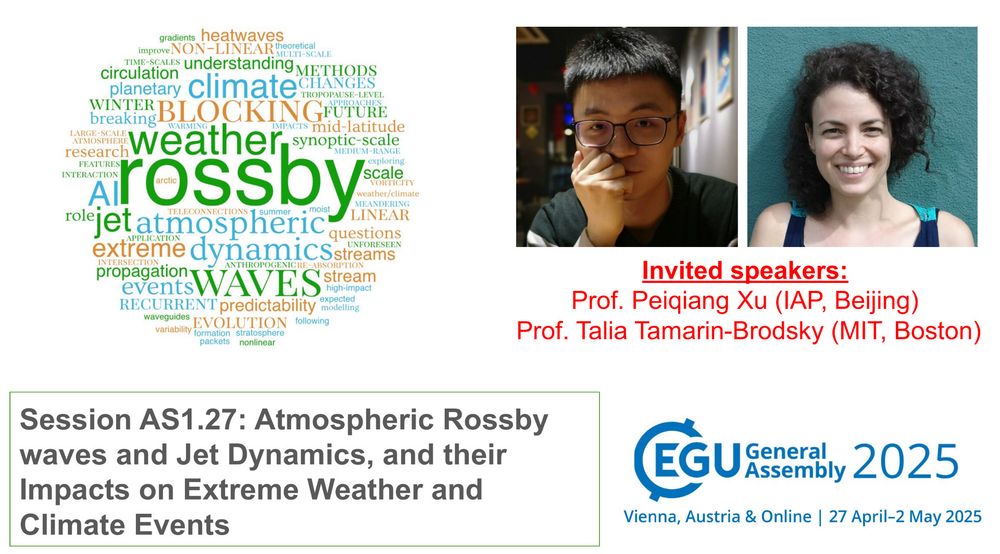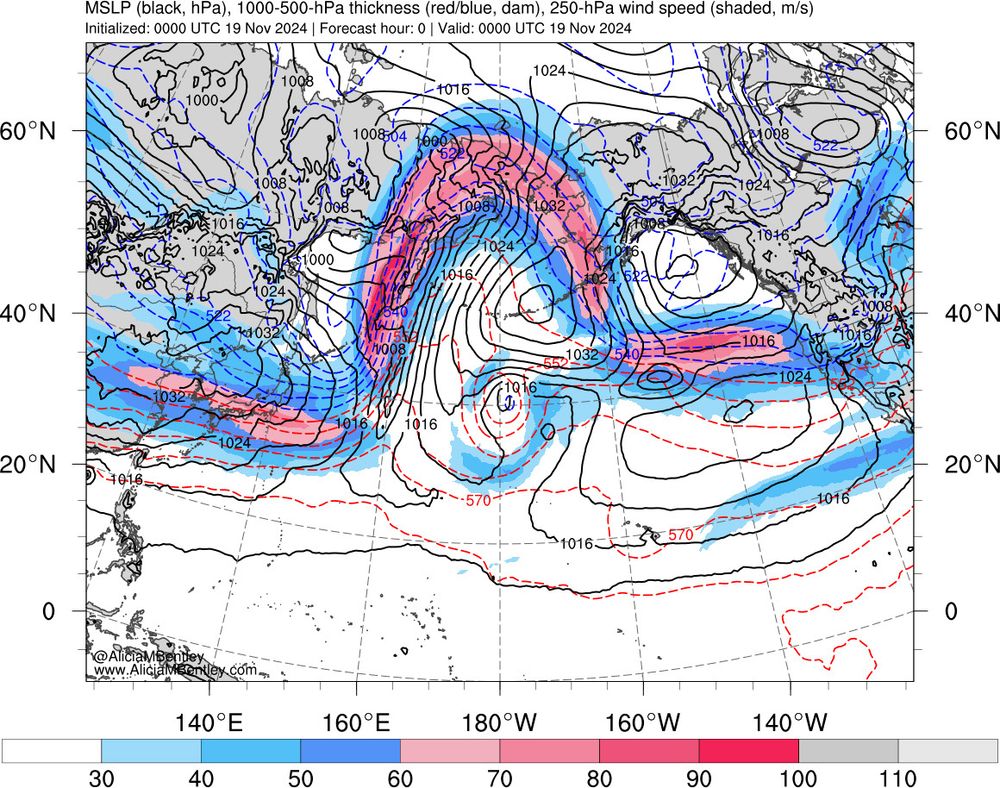
Tackling climate research problems from a weather-centered perspective 🌦🌀🌡

(Anomalous 2m T in blue; magenta: jet stream; orange: sfc wind)

(Anomalous 2m T in blue; magenta: jet stream; orange: sfc wind)
In the current event, I like how it is the same trough now above the southern US that moves over the Atlantic to support the strong Atlantic cyclogenesis 🌀




In the current event, I like how it is the same trough now above the southern US that moves over the Atlantic to support the strong Atlantic cyclogenesis 🌀
Another impression of the importance of Rossby wave breaking events for different types of impactful extremes!




Another impression of the importance of Rossby wave breaking events for different types of impactful extremes!
Notice the <-3σ anomalies (thanks @aliciambentley.bsky.social for the maps).



Notice the <-3σ anomalies (thanks @aliciambentley.bsky.social for the maps).
Low-level winds speeds over the area exceed 5 standard deviations in anomaly (though wind speed is not gaussian, but ok).
But why are they so strong?

Low-level winds speeds over the area exceed 5 standard deviations in anomaly (though wind speed is not gaussian, but ok).
But why are they so strong?
If your work involves large-scale dynamics and extreme weather/climate events, then consider submitting your abstract to the "Atmospheric Rossby Waves and Jet Dynamics" session! 🌬️〰️🌀
Invited speakers: Peiqiang Xu (IAP) and Talia Tamarin-Brodsky (MIT)!

If your work involves large-scale dynamics and extreme weather/climate events, then consider submitting your abstract to the "Atmospheric Rossby Waves and Jet Dynamics" session! 🌬️〰️🌀
Invited speakers: Peiqiang Xu (IAP) and Talia Tamarin-Brodsky (MIT)!
The cyclone is rapidly developing a deep, symmetric warm core as a result of the warm seclusion process (and maybe of some latent heat release?).


The cyclone is rapidly developing a deep, symmetric warm core as a result of the warm seclusion process (and maybe of some latent heat release?).
Was it maybe a diabatic Rossby wave? One would need to check, but the likely presence of upper-level forcing for ascent would exclude it. (5/7)


Was it maybe a diabatic Rossby wave? One would need to check, but the likely presence of upper-level forcing for ascent would exclude it. (5/7)
This heavy precipitation area was likely tied to the right entrance of a short jet streak over the east Pacific. (4/7)


This heavy precipitation area was likely tied to the right entrance of a short jet streak over the east Pacific. (4/7)



Downward-bending isentropes mark the warm core at the center. Winds around it decrease with height, following the thermal wind law (1/7)


Downward-bending isentropes mark the warm core at the center. Winds around it decrease with height, following the thermal wind law (1/7)
🦋🦋🦋🦋🦋

🦋🦋🦋🦋🦋
Left: northerly wind (coming out of the page) close to the surface in the cold air
Right: easterly wind (right-to-left, along cross-sect.) at the warm side.
The frontal boundary is visible in wind, too!


Left: northerly wind (coming out of the page) close to the surface in the cold air
Right: easterly wind (right-to-left, along cross-sect.) at the warm side.
The frontal boundary is visible in wind, too!
Model sounding indicate saturated conditions, anticyclonic veering with height ↘️⬇️↙️⬅️↖️ and a low-level jet.


Model sounding indicate saturated conditions, anticyclonic veering with height ↘️⬇️↙️⬅️↖️ and a low-level jet.
Here (thanks @TropicalTidbits) we see the warm temperature advection in warm colors over Poland/Czechia, and the strong temperature gradient in purple. Look at the wind change across the front!

Here (thanks @TropicalTidbits) we see the warm temperature advection in warm colors over Poland/Czechia, and the strong temperature gradient in purple. Look at the wind change across the front!
Boris is supported by the the jet streak over Italy/Balkans: as the cut-off won't move much in the next few days, Boris will keep affecting the same regions.


Boris is supported by the the jet streak over Italy/Balkans: as the cut-off won't move much in the next few days, Boris will keep affecting the same regions.
It continues since Tuesday and is the responsible of the chilly weather we had during the week over western Europe ❄️


It continues since Tuesday and is the responsible of the chilly weather we had during the week over western Europe ❄️
For example, focus on the cloudy area over CZ, where it is raining a lot. At the surface, strong northerly flow⬇️; at 300hPa, south-easterlies↖️ almost orthogonal to the isobars.

For example, focus on the cloudy area over CZ, where it is raining a lot. At the surface, strong northerly flow⬇️; at 300hPa, south-easterlies↖️ almost orthogonal to the isobars.
A thread with some meteorological aspects of this storm I found fascinating:


A thread with some meteorological aspects of this storm I found fascinating:
Next steps: extending the eigenvalue solution to non-zonally symmetric jets, trying to approach real-world flows.
Thanks to the lead author, A. Segalini, and to V. Wirth and G. Messori for this journey!

Next steps: extending the eigenvalue solution to non-zonally symmetric jets, trying to approach real-world flows.
Thanks to the lead author, A. Segalini, and to V. Wirth and G. Messori for this journey!
Because double jet configurations, that have been linked to Rossby waveguides, amplified Rossby waves and extreme events, feature jets at different latitudes!
We tried to assess waveguidability in double jet configurations and... (10/12)

Because double jet configurations, that have been linked to Rossby waveguides, amplified Rossby waves and extreme events, feature jets at different latitudes!
We tried to assess waveguidability in double jet configurations and... (10/12)




